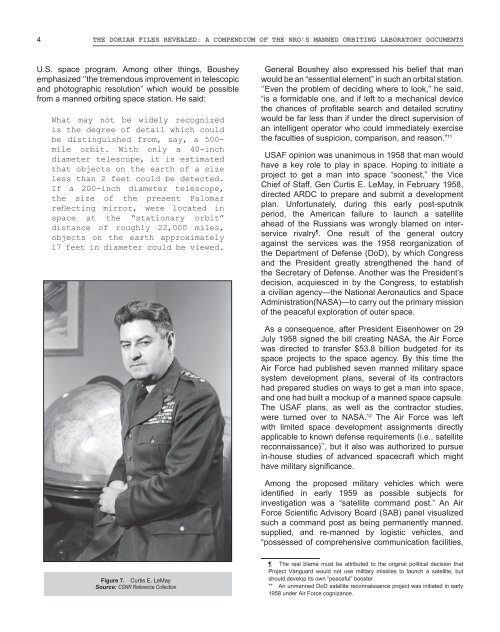NRO-MOL_2015
Create successful ePaper yourself
Turn your PDF publications into a flip-book with our unique Google optimized e-Paper software.
4 The Dorian Files Revealed: a Compendium of the <strong>NRO</strong>’s Manned Orbiting Laboratory Documents<br />
U.S. space program. Among other things, Boushey<br />
emphasized ‘’the tremendous improvement in telescopic<br />
and photographic resolution” which would be possible<br />
from a manned orbiting space station. He said:<br />
What may not be widely recognized<br />
is the degree of detail which could<br />
be distinguished from, say, a 500-<br />
mile orbit. With only a 40-inch<br />
diameter telescope, it is estimated<br />
that objects on the earth of a size<br />
less than 2 feet could be detected.<br />
If a 200-inch diameter telescope,<br />
the size of the present Palomar<br />
reflecting mirror, were located in<br />
space at the “stationary orbit”<br />
distance of roughly 22,000 miles,<br />
objects on the earth approximately<br />
17 feet in diameter could be viewed.<br />
General Boushey also expressed his belief that man<br />
would be an “essential element” in such an orbital station.<br />
‘’Even the problem of deciding where to look,” he said,<br />
“is a formidable one, and if left to a mechanical device<br />
the chances of profitable search and detailed scrutiny<br />
would be far less than if under the direct supervision of<br />
an intelligent operator who could immediately exercise<br />
the faculties of suspicion, comparison, and reason.” 11<br />
USAF opinion was unanimous in 1958 that man would<br />
have a key role to play in space. Hoping to initiate a<br />
project to get a man into space “soonest,” the Vice<br />
Chief of Staff, Gen Curtis E. LeMay, in February 1958,<br />
directed ARDC to prepare and submit a development<br />
plan. Unfortunately, during this early post-sputnik<br />
period, the American failure to launch a satellite<br />
ahead of the Russians was wrongly blamed on interservice<br />
rivalry . One result of the general outcry<br />
against the services was the 1958 reorganization of<br />
the Department of Defense (DoD), by which Congress<br />
and the President greatly strengthened the hand of<br />
the Secretary of Defense. Another was the President’s<br />
decision, acquiesced in by the Congress, to establish<br />
a civilian agency—the National Aeronautics and Space<br />
Administration(NASA)—to carry out the primary mission<br />
of the peaceful exploration of outer space.<br />
As a consequence, after President Eisenhower on 29<br />
July 1958 signed the bill creating NASA, the Air Force<br />
was directed to transfer $53.8 billion budgeted for its<br />
space projects to the space agency. By this time the<br />
Air Force had published seven manned military space<br />
system development plans, several of its contractors<br />
had prepared studies on ways to get a man into space,<br />
and one had built a mockup of a manned space capsule.<br />
The USAF plans, as well as the contractor studies,<br />
were turned over to NASA. 12 The Air Force was left<br />
with limited space development assignments directly<br />
applicable to known defense requirements (i.e., satellite<br />
reconnaissance) ** , but it also was authorized to pursue<br />
in-house studies of advanced spacecraft which might<br />
have military significance.<br />
Among the proposed military vehicles which were<br />
identified in early 1959 as possible subjects for<br />
investigation was a “satellite command post.” An Air<br />
Force Scientific Advisory Board (SAB) panel visualized<br />
such a command post as being permanently manned,<br />
supplied, and re-manned by logistic vehicles, and<br />
“possessed of comprehensive communication facilities,<br />
Figure 7. Curtis E. LeMay<br />
Source: CSNR Reference Collection<br />
The real blame must be attributed to the original political decision that<br />
Project Vanguard would not use military missiles to launch a satellite, but<br />
should develop its own “peaceful” booster<br />
** An unmanned DoD satellite reconnaissance project was initiated in early<br />
1958 under Air Force cognizance.

















